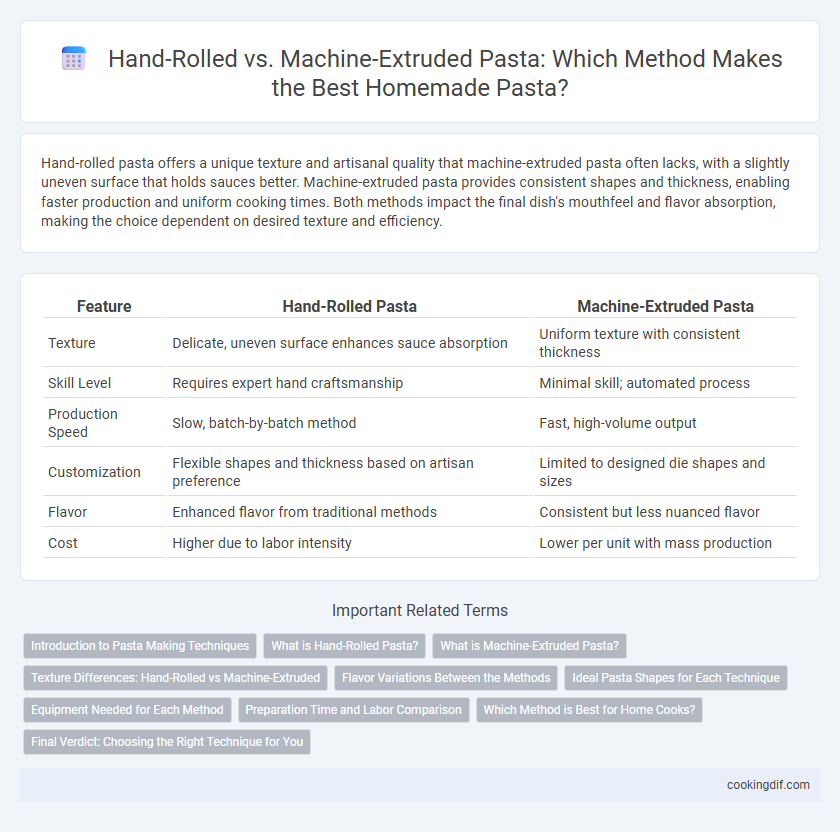Hand-rolled pasta offers a unique texture and artisanal quality that machine-extruded pasta often lacks, with a slightly uneven surface that holds sauces better. Machine-extruded pasta provides consistent shapes and thickness, enabling faster production and uniform cooking times. Both methods impact the final dish's mouthfeel and flavor absorption, making the choice dependent on desired texture and efficiency.
Table of Comparison
| Feature | Hand-Rolled Pasta | Machine-Extruded Pasta |
|---|---|---|
| Texture | Delicate, uneven surface enhances sauce absorption | Uniform texture with consistent thickness |
| Skill Level | Requires expert hand craftsmanship | Minimal skill; automated process |
| Production Speed | Slow, batch-by-batch method | Fast, high-volume output |
| Customization | Flexible shapes and thickness based on artisan preference | Limited to designed die shapes and sizes |
| Flavor | Enhanced flavor from traditional methods | Consistent but less nuanced flavor |
| Cost | Higher due to labor intensity | Lower per unit with mass production |
Introduction to Pasta Making Techniques
Hand-rolled pasta involves shaping dough by hand using simple tools like rolling pins, resulting in uneven thickness and a rustic texture prized in artisanal cooking. Machine-extruded pasta uses molds to create uniform shapes and consistent thickness, ideal for mass production and precise cooking times. Understanding these techniques highlights the influence of pasta texture and shape on sauce adherence and overall dish quality.
What is Hand-Rolled Pasta?
Hand-rolled pasta is crafted by manually pressing and shaping the dough using hands or a rolling pin, resulting in a denser texture and more irregular, artisanal shapes compared to machine-extruded pasta. This traditional method preserves the dough's integrity, allowing it to retain sauces better due to its porous surface. Chefs often prefer hand-rolled pasta for its distinctive texture and superior flavor absorption in dishes like pappardelle and tagliatelle.
What is Machine-Extruded Pasta?
Machine-extruded pasta is produced by forcing dough through shaped dies using industrial pasta machines, resulting in consistent shapes and textures ideal for mass production. This method allows for a wide variety of pasta types such as penne, rigatoni, and fusilli, which are difficult to achieve by hand. The extrusion process also impacts the pasta's surface, often creating ridges that help sauce adhere better, enhancing flavor absorption during cooking.
Texture Differences: Hand-Rolled vs Machine-Extruded
Hand-rolled pasta offers a unique texture with a delicate, uneven surface that allows sauces to cling better, enhancing flavor absorption. Machine-extruded pasta typically has a uniform, smooth surface that provides consistent cooking but may result in less sauce adherence. The choice between hand-rolled and machine-extruded pasta significantly impacts the final dish's mouthfeel and sauce integration.
Flavor Variations Between the Methods
Hand-rolled pasta often delivers a more delicate texture and enhanced flavor due to the gentle pressure applied, preserving the flour's natural nuttiness. Machine-extruded pasta, shaped by dies, can develop a slightly different taste profile influenced by the extrusion process and the type of die used. Variations in surface texture also impact sauce adherence, further affecting flavor perception between the methods.
Ideal Pasta Shapes for Each Technique
Hand-rolled pasta excels in creating delicate shapes like pappardelle, fettuccine, and orecchiette, where precise thickness and texture are crucial for sauces to cling effectively. Machine-extruded pasta is ideal for complex shapes such as penne, rigatoni, and fusilli, providing uniformity and hollow or ridged structures that enhance flavor capture and cooking consistency. Selecting the right technique depends on the desired pasta shape, textural qualities, and sauce pairing to achieve authentic Italian culinary results.
Equipment Needed for Each Method
Hand-rolled pasta requires minimal equipment, primarily a rolling pin, a flat surface for dough rolling, and a sharp knife or pasta cutter for shaping. Machine-extruded pasta demands specialized tools such as a pasta extruder or press, which shapes the dough through various dies to create consistent pasta shapes quickly. While hand-rolling is labor-intensive and ideal for rustic, artisanal textures, machine extrusion streamlines production and ensures uniformity in commercial pasta making.
Preparation Time and Labor Comparison
Hand-rolled pasta requires significantly more preparation time, demanding skilled labor to achieve the desired thinness and texture, which results in a more artisanal product. Machine-extruded pasta accelerates production by automating the shaping process, reducing manual labor and allowing for consistent output at a faster pace. This efficiency makes machine extrusion ideal for large-scale production, while hand-rolling remains favored for traditional, small-batch pasta making.
Which Method is Best for Home Cooks?
Hand-rolled pasta offers a traditional texture and artisanal quality that enhances flavor, making it ideal for home cooks seeking authenticity and control over thickness and shape. Machine-extruded pasta provides consistency and efficiency, perfect for those who prioritize convenience and uniformity in everyday cooking. For home cooks, the best method depends on balancing hands-on craftsmanship and time-saving practicality.
Final Verdict: Choosing the Right Technique for You
Hand-rolled pasta delivers a tender texture and rustic appearance, favored for traditional dishes and artisanal quality. Machine-extruded pasta offers consistent shapes and faster production, ideal for large batches and uniform cooking. Selecting the right technique depends on your emphasis on authenticity versus efficiency in pasta preparation.
Hand-rolled vs machine-extruded for pasta making Infographic

 cookingdif.com
cookingdif.com